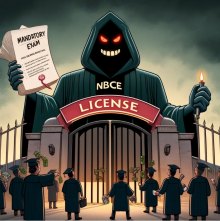MD's & DO's Have Done Away with Their Part IV Exams - Why is the NBCE Still Pushing Theirs?

The COVID-19 pandemic has brought significant challenges to the forefront of healthcare education and licensure, prompting major changes in how clinical competencies are assessed for medical and osteopathic students. The elimination of the Step 2 Clinical Skills (CS) exam for MDs and the Level 2 Performance Evaluation (PE) for DOs offers valuable lessons for the chiropractic profession as it grapples with similar issues surrounding the NBCE Part IV exam.
The Elimination of Step 2 CS
Background
Step 2 CS was a critical component of the United States Medical Licensing Examination (USMLE) series, designed to assess medical students' clinical skills through standardized patient encounters. However, in March 2020, the exam was suspended due to the COVID-19 pandemic. The suspension highlighted significant logistical challenges, including safety concerns and the high cost of conducting the exam across limited testing centers.
Impact
With Step 2 CS suspended, medical schools increased their responsibility for assessing clinical skills. This shift led to enhanced internal evaluations, including more frequent Objective Structured Clinical Examinations (OSCEs), direct faculty observations, and the use of advanced simulation labs.
The suspension of Step 2 CS has become permanent, with the USMLE and its parent organizations exploring new methods for clinical skills assessment. These include remote and virtual assessments, as well as integrated evaluations within other USMLE steps.
The Review of Level 2 PE
Background
Level 2 PE, part of the Comprehensive Osteopathic Medical Licensing Examination (COMLEX-USA), assessed clinical skills through standardized patient interactions. Similar to Step 2 CS, the exam was suspended in March 2020 due to the pandemic.
Impact
Osteopathic medical schools took on a greater role in evaluating clinical competencies, implementing more OSCEs, expanded clinical training, and enhanced simulation experiences. This transition ensured that students continued to receive rigorous clinical skills training despite the suspension of Level 2 PE.
Level 2 PE has been eliminated with the NBOME actively exploring alternative assessment methods. This includes potential pilot programs and stakeholder consultations to develop effective, equitable, and accessible clinical skills evaluations.
Applying These Lessons to Chiropractic Licensure
Similar Challenges
The chiropractic profession faced comparable challenges during the COVID-19 pandemic, particularly with the NBCE Part IV exam, which assesses clinical skills through practical exams. The logistical difficulties, safety concerns, and high costs associated with centralized testing have highlighted the need for reform.
Proposed Changes
Drawing from the experiences of MD and DO licensure reforms, the chiropractic profession should be considering similar changes and the shuttering of the Part IV exam which has been an albatross around the necks of recent graduates. Chiropractic schools, already accredited by reputable bodies, can simply take on a larger role in assessing clinical competencies. This could include more frequent OSCEs, direct observations by faculty, and the use of advanced simulation technologies. If that is even needed.
Conclusion
The experiences of the medical and osteopathic professions in eliminating their clinical skills exams provide a clear path forward for the chiropractic profession. By adopting similar reforms, the NBCE can address the challenges of the Part IV exam, reduce burdens on students, and enhance the overall quality of chiropractic education and licensure. It’s time for the chiropractic community to embrace these lessons and move towards a more efficient, equitable, and innovative approach to assessing clinical competencies.

Blogs
- The Chiropractic Cartel: A Look Back at Bias in Accreditation and its Imact on Today's Profession
- Inside Montana's Chiropractic Monopoly: ACA & MCA's Brazen Board Takeover
- Concerns Grow About Control of the NY State Chiropractic Board by the ACA - Use of X-ray in NY Under Threat
- Reproductive Health Information and Chiropractic Care: Navigating New Privacy Regulations
- Navigating Substance Use Disorder (SUD) Consent: What Chiropractors Need to Know













